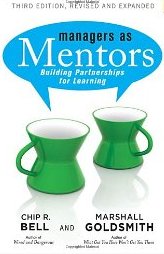 I recently checked off Managers as Mentors – Building Partnerships For Learning by Chip R. Bell and Marshall Goldsmith on my 2013 reading list. The subtitle intrigued me as much as the title did. Building partnerships for learning is the process of taking what “I learned” to what “We learned.”
I recently checked off Managers as Mentors – Building Partnerships For Learning by Chip R. Bell and Marshall Goldsmith on my 2013 reading list. The subtitle intrigued me as much as the title did. Building partnerships for learning is the process of taking what “I learned” to what “We learned.”
As a coach, and a mentor at times, I have discovered that not only is it better to learn together, but it is also incredible what you can learn watching others learn. Bell and Goldsmith have hit a homerun on the third edition of this effort. I will admit that I did not dive into the first to additions, but if you did, the authors have assured us that there are new stories and lessons, much the result of reader feedback.
There are enough takeaways in this book to write a book – well, I guess they already thought of that. The mentoring model that this book is built around holds the belief that great mentoring requires four core competencies, each which can be used to mentor in a variety of ways.
Bell and Goldsmith use the mnemonic “SAGE” to describe the progression of a productive mentoring process. For sake of time and space, I will cover these four steps in this post but they only make up about half the book.
SURRENDERING – Leveling the Learning Field
As a coach, I think this step is the one that resonates the most with me. As the authors put it, “It all begins with surrendering to the process of learning instead of pursuing the program of teaching.” They go on to say; “Surrendering means completely relinquishing any effort to control or manipulate the outcome. Surrendering means putting all effort into being completely authentic, real, and mask free.”
The idea is that we get out of the way of ourselves and allow the process to produce the results. I read this to say that the first step in any successful mentoring effort is to be authentic and transparent and to build rapport with the protégé.
ACCEPTING – Creating a Safe Haven for Risk Taking
The next step is accepting. “Accepting means inviting the learner to be courageous, to take the risks needed to unfreeze old habits, and embrace and internalize new practices.” Additionally, “When mentors listen to learn (not to instruct), when mentors question to unearth (not to prove), and when mentors converse to explore (not to boast or best), the protégé experiences acceptance.”
Go back and read that again and think about your prior mentoring experiences. Would these ideas have made a difference in your experience? The key is found in the final word – acceptance. Accepting the person and their circumstance eliminates the roadblocks that can hinder the process.
GIFTING – The Main Event
I am very pleased that the authors have included this step. So much of what we experience in life revolves around someone else’s motives. As the authors suggest; “True gifting is the expression of abundance without any expectation of a gesture in response. And it is deliberate and intentional action rather than simply a personality trait or kind manner.”
When was the last time you did something for someone with no expectation of anything in return? The point here is again, that when our motives our pure, the person we are working with senses that. When they know you are making an investment in them, and believe in them, it empowers them to move forward in a positive manner.
EXTENDING – Nurturing a Self-Directed Learner
The authors wrap up the SAGE model by recognizing that the mentoring process can create codependency. Think about it, the protégé has gone through a huge transformation and for the most part, it has been a product of the relationship. The final step is to extend that learning and change beyond that relationship.
Bell and Goldsmith state; “As new forms of learning become available, the protégé discovers new routes of self-sufficiency. The ultimate extension takes the mentor completely out of the equation, leaving the protégé to find his or her own way to competence – and independence.”
I am blessed to have several mentors in my life that help me along the way. That being said, I realize that the only person that will actually create change in my life is me. I know this because my mentors have followed a model close to that described by the authors. So I can tell you with full confidence, that this works. Mentoring makes a difference and makes a significant difference when it is done right.
I realize this was a little longer than my typical entry, but this is an important topic. The mentoring process has changed my life and it can change yours as well. Bell and Goldsmith have provided the blueprint to mentor your way to greater achievement and greater significance.
My encouragement today is for you to make the commitment to building partnerships for learning and get involved in the mentoring process. Find someone that can help you take it to the next level and do the same for someone else. There is no better time than right now!
For more on Managers As Mentors click here
***********************************************************************
Don’t miss a single post from Building What Matters by subscribing at the top left of this page.
Help support us by clicking here and Liking our facebook page
Barry Smith 7/24/13 photo courtesy of Amazon © Building What Matters 2013


I read the book, loved it, gave it out to others. That’s my best compliment.
Thanks for your great summary post. Anyone, wanting to be a Mentor should read this post and the book.
Thanks Dan and I totally agree. This one is a must read for any mentor, manager or leader.
Barry, I can’t wait to read this book since I am involved in setting up a mentorship program for one of my potential clients. I always feel I learn so much from you. You have become a mentor to me!
Terri
Wow! Thanks Terri. I definitely appreciate the kind words and appreciate that I have been able to add value. Let me know if there is anything I can do to help on your project.
Great post Barry. It has been added to my list. This needs to be a critical piece in the conversation as we transition the baby boomers out of the workforce. An amazing amount of knowledge will leave unless we intentionally look for opportunities to learn.